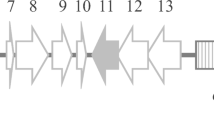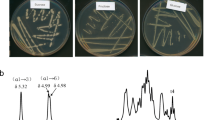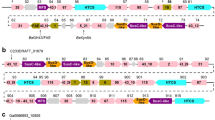Abstract
The industrial Leuconostoc strain B/110-1-2 producing dextran and dextran derivatives was taxonomically identified by 16S rRNA as L. citreum. Its dextransucrase enzymes were characterized according to their cellular location and reaction specificity. In the presence of sucrose, the strain B/110-1-2 produced two cell-associated dextransucrases (31.54% of the total glucosyltransferase activity) with molecular weights of 160 and 240 kDa and a soluble dextransucrase (68.46%) at 160–180 kDa. Two open reading frames (ORF) coding for L. citreum strain B/110-1-2 dextransucrases were identified. One of them shared a 52% identity with the alternansucrase ASR of L. citreum NRRL B-1355 and with a putative annotated alternansucrase sequence found in the genome of L. citreum KM20. The structural analysis (HPAEC-PAD, HPSEC, and 13C-NMR) of the polymer and oligodextrans produced by the B/110-1-2 dextransucrases suggest this novel glucansucrase has specificity similar to a dextransucrase but not to an alternansucrase, producing a soluble linear dextran with glucose molecules linked mainly in α-1,6 and α-1,3 with α-1,4 branches. These results enhance the understanding of this industrially significant strain and will aid in distinguishing between physiologically similar Leuconostoc spp. strains.




Similar content being viewed by others
References
Ah-Rum Y, Lee S, Jang M, Park J, Eom H, Soo Han N, Kim T (2009) Cloning of dextransucrase gene from Leuconostoc citreum HJ-P4 and its high level expression in E. coli by low temperature induction. J Microbiol Biotechnol 19:829–835
Altschul SF, Madden TL, Schäffer AA, Zhang J, Zhang Z, Miller W, Lipman DJ (1997) Gapped BLAST and PSI-BLAST: a new generation of protein database search programs. Nucleic Acids Res 25:3389–3402
Arguello-Morales M, Remaud-Simeon M, Pizzut S, Sarcabal P, Willemot RM, Monsan P (2000) Sequence analysis of the gene encoding alternansucrase, a sucrose glucosyltransferase from Leuconostoc mesenteroides NRRL B-1355. FEMS Microbiol Lett 182:81–85
Bell A, Santiesteban CM (2000) Dextran. In: Gálvez L, Reselló S, Cabello A, Villamil, G, García A, Martín A, Costales R (eds) Handbook of sugar cane derivatives, 3rd edn, Chap 5.1, pp 323–326
Bozonnet S, Dols-Laffargue M, Fabre E, Pizzut S, Remaud-Simeon M, Monsan P, Willemot RM (2002) Molecular characterization of DSR-E, an α-1, 2 linkage-synthesizing dextransucrase with two catalytic domains. J Bacteriol 184:5753–5761
Brossard L (1968) Estudio de la dextrana Cubana. Revista ICIDCA Havana Cuba 2(1):41–47
Castellanos E, Iraizoz A, Bataille B, Pedráz JL, Heinamaki J (2006) Development and optimization of a novel sustained-release dextran tablet formulation for propranolol hydrochloride. Int J Pharm 317:32–39
Castellanos E, Iraizoz A, Abdelsam E, Durand D, Delarbre JL, Bataille B (2008) A sugar cane native dextran as an innovative functional excipient for the development of pharmaceutical tablets. EJPB 68:319–329
Chellapandian M, Larios C, Sánchez-González M, López-Munguía A (1998) Production and properties of a dextransucrase from Leuconostoc mesenteroides IBT-PQ isolated from ‘pulque’, a traditional Aztec alcoholic beverage. J Ind Microbiol Biotechnol 21:51–56
Cote LG, Leathers TD (2005) A method for surveying and classifying Leuconostoc spp. Glucansucrases according to strain-dependent acceptor products patterns. J Ind Microbiol Biotechnol 32:53–60
Djouzi Z, Andrieux C, Pelenc V, Somarriba S, Popot F, Paul F, Monsan P, Szylit O (1995) Degradation and fermentation of α-glucooligosaccharides by bacterial strains from human colon: in vitro and in vivo studies in gnotobiotic rats. J Appl Bacteriol 79:117–127
Dols M, Remaud-Simeon M, Willemot RM, Vignon M, Monsan P (1998) Characterisation of the different dextransucrase activities excreted in glucose, fructose or sucrose medium by Leuconostoc mesenteroides NRRL B-1299. Appl Environ Microbiol 64:1298
Fabre E, Bozonnet S, Arcache A, Willemot RM, Vignon M, Monsan P, Remaud-Simeon M (2005) Role of the two catalytic domains of DSR-E dextransucrase and their involvement in the formation of highly α-1, 2 branched dextran. J Bacteriol 187:296–303
Garvie EI (1984) Separation of species of the genus Leuconostoc and differentiation of the Leuconostoc from other lactic acid bacteria. In: Bergan T (ed) Methods in microbiology, vol 16. Academic Press, London, pp 147–178
Groenwall AJ, Ingelman BJA (1948) Manufacture of infusion and injection fluids. U.S. Patent 2, pp 437–518
Henrissat B, Davies G (1997) Structural and sequence based classification of glycoside hydrolases. Curr Opin Struct Biol 7:637–644
Kim D, Robyt JF (1995) Production, selection and characteristics of mutants of Leuconostoc mesenteroides B-742 constitutive for dextransucrases. Enzyme Microbiol Technol 17:689–695
Kobayashi M, Matsuda K (1974) The dextransucrase isoenzymes of Leuconostoc mesenteroides NRRL B-1299. Biochim Biophys Acta 370:441–449
Koepsell HJ, Tsuchiya HM, Hellman NN, Kazenko A, Hoffman CA, Sharpe ES, Jackson RW (1953) Enzymatic synthesis of dextran. Acceptor specificity and chain initiation. J Biol Chem 200:793–801
Larkin MA, Blackshields G, Brown NP, Chenna R, McGettigan PA, McWilliam H, Valentin F, Wallace IM, Wilm A, Lopez R, Thompson JD, Gibson TJ, Higgins DG (2007) Clustal W and Clustal X version 2.0. Bioinformatics 23:2947–2948
Michelena G, Santiesteban CM (2000) Injectable iron dextran. In: Gálvez L, Reselló S, Cabello A, Villamil, G, García A, Martín A, Costales R (eds) Handbook of sugar cane derivatives, 3rd edn, Chap 5.13, pp 383–385
Miller AW, Robyt JF (1986) Detection of dextransucrase and levansucrase on polyacrylamide gels by the periodic acid-Schiff stain: staining artifacts and their prevention. Anal Biochem 156:357–363
Monchois V, Remaud-Simeon M, Monsan P, Willemot RM (1998) Cloning and sequencing of an extracellular dextransucrase (DSR-B) from Leuconostoc mesenteroides NRRL B1299-synthesizing only α(1–6) glucan. FEMS Microbiol Lett 159:307–315
Mooser G (1992) Glycosidases and glycosyltransferases. Enzymes 20:187–221
Moulis C, Arcache A, Escalier PC, Rinaudo M, Bouchu A, Monsan P, Remaud-Simeon M, Potocki-Veronese G (2006) High-level production and purification of a fully active recombinant dextransucrase from Leuconostoc mesenteroides NRRL B-512F. FEMS Microbiol Lett 261:203–210
Moulis C, Joucla G, Harrison D, Fabre E, Potocki-Veronese G, Monsan P, Remaud-Simeon M (2006) Understanding the polymerization mechanism of Glycoside-Hydrolase Family 70 Glucansucrases. J Biol Chem 281:31254–31267
Nuebauer H, Bauche A, Mollet B (2003) Molecular characterization and expression analysis of the dextransucrase DsrD of Leuconostoc mesenteroides Lcc4 in homologous and heterologous Lactococcus lactis cultures. Microbiology 149:973–982
Olivares-Illana V, Wacher-Rodarte C, Le Borgne S, López-Munguía A (2002) Characterization of a cell-associated inulosucrase from a novel source: A Leuconostoc citreum strain isolated from Pozol, a fermented corn beverage of Mayan origin. J Ind Microbiol Biotechnol 28:112–117
Olivares-Illana V, López-Munguía A, Olvera C (2003) Molecular characterization of inulosucrase from Leuconostoc citreum: a fructosyltransferase within a glucosyltransferase. J Bacteriol 185:3606–3612
Olvera C, Fernández-Vázquez JL, Ledezma-Candanoza L, López-Munguía A (2007) Role of the C-terminal región of dextransucrase from Leuconostoc mesenteroides IBT-PQ in cell anchoring. Microbiology 153:3994–4002
Paul F, Lopez-Munguia A, Remaud M, Pelenc V, Monsan P (1992) Method of the production of α-1,2 oligodextrans using Leuconostoc mesenteroides NRRL B-1299, U.S. Patent 5, pp 141–858
Remaud-Simeon M, Willemot RM, Sarcabal P, Potocki G, Monsan P (2000) Glucansucrases: molecular engineering and oligosaccharide synthesis. J Mol Catal B Enzym 10:117–128
Remaud-Simeon M, López-Munguía A, Pelenc V, Paul F, Monsan P (1994) Production and use of glucosyltransferase from L. mesenteroides NRRL B-1299 for the synthesis of oligosaccharides containing α(1–2) linkages. Appl Biochem Biotechnol 44:101–117
Sambrook J, Russell DW (2001) Molecular cloning: a laboratory manual, 3rd edn. Cold Spring Harbor Laboratory Press, Cold Spring Harbor
Seymour FR, Knapp RD (1980) Structural analysis of dextrans from strains of Leuconostoc and related genera that contain 3-O-α glucosylated-d-glucopyranosyl residues at the branched points or in consecutive linear position. Carbohydr Res 81:105–129
Seymour FR, Knapp RD, Bishop SH (1976) Determination of the structure of dextran by C-nuclear resonance spectrometry. Carbohydr Res 51:179–194
Sidebotham R (1974) Dextrans. Adv Carbohydr Chem Biochem 30:371–444
Slodki ME, England RE, Plattner RD, Dick WE (1986) Methylation analyses of NRRL dextrans by capillary gas-liquid chromatography. Carbohydr Res 156:199–206
Smith EE (1970) Biosynthetic relation between the soluble and insoluble dextrans produced by Leuconostoc mesenteroides NRRL B-1299. FEBS Lett 12:33–37
Soetaert W, Schwengers D, Bucholz K and Vandamme EJ (1995) A wide range of carbohydrate modifications by a single microorganism: Leuconostoc mesenteroides. In: Petersen SB, Svensson B, Pederson S (eds) Carbohydrate bioengineering, vol 10. Elsevier, Amsterdam, pp 351–358
Sumner J, Howell S (1935) A method for determination of invertase activity. J Biol Chem 108:51–54
van Hijum SAFT, Kralj S, Ozimek LK, Dijkhuizen L, van Deel-Schutten IGH (2006) Structure-function relationships of glucansucrase and fructansucrase enzymes from lactic acid bacteria. MMBR 70:157–176
Wilke-Douglas M, Perchorowicz JT, Houck CM, Thomas BR (1989) Methods and compositions for altering physical characteristics of fruit and fruit products, PCT Patent WO 89/12386
Yalin Y, Jin L, Jianhua W, Da T, Zigang T (2008) Expression and characterization of dextransucrase gene dsrX from Leuconostoc mesenteroides in Escherichia coli. J Biotechnol 133:505–512
Zahnley JC, Smith MR (1995) Insoluble glucan formation by Leuconostoc mesenteroides NRRL B-1355. Appl Environ Microbiol 61:1120–1123
Zhang H, Hu Y, Zhu C, Zhu B, Wang Y (2008) Cloning, sequencing and expression of a dextransucrase gene (dexYG) from Leuconostoc mesenteroides. Biotechnol Lett 30:1441–1446
Acknowledgments
R. Fraga holds a contract as Research Associated from INRA, Toulouse. We express our gratitude to Elisse Champion and Richard Guyton by their technical support and advice for the HPAEC-PAD and HPSEC analysis, respectively. We also thank Dr. Joan Combie for the style correction of the manuscript.
Author information
Authors and Affiliations
Corresponding author
Rights and permissions
About this article
Cite this article
Fraga Vidal, R., Martínez, A., Moulis, C. et al. A novel dextransucrase is produced by Leuconostoc citreum strain B/110-1-2: an isolate used for the industrial production of dextran and dextran derivatives. J Ind Microbiol Biotechnol 38, 1499–1506 (2011). https://doi.org/10.1007/s10295-010-0936-x
Received:
Accepted:
Published:
Issue Date:
DOI: https://doi.org/10.1007/s10295-010-0936-x




